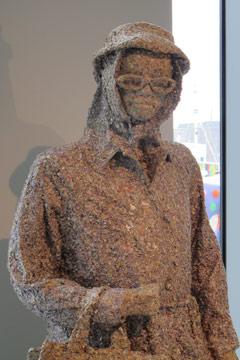Money can't buy me love

Eleanor Rigby sculpture to go on display at Museum of Liverpool
The Museum of Liverpool is to display a sculpture of one of the city’s most well-known characters, made famous by the Beatles song bearing her name, Eleanor Rigby.
Created by Liverpool-born artist and sculptor Leonard J Brown, the 5ft 2 inch sculpture has been crafted out of £1million worth of old bank notes; a stark contrast when compared to the ‘bag lady’ who inspired the work, and died without a penny to her name.
Just as the lyrics go - ‘all the lonely people’ - Leonard’s juxtaposition of the poverty-stricken Eleanor Rigby and her rebirth using old money, demonstrates the relationship between wealth and poverty, which Leonard hopes will pass on a positive message to visitors.
A note accompanying the sculpture says ‘I cried because I had no shoes, until I saw a man who had no feet’, a saying which Leonard was often reminded of as a youngster growing up in Liverpool and believes is particularly poignant and still relevant today.
Leonard said:
“The sculpture serves to show people that money isn’t the only way to make you happy, or indeed ‘buy you love’ and we should all be thankful for what we have. There are people in every town and city like Eleanor Rigby who live a lonely life, and whose only worldly goods are kept in the bags that they carry.”
Born in New Henderson Street off Park Road in Liverpool in the 1940s, Leonard recalls Post-War Liverpool Waterfront as a derelict area following heavy bombing of the city. As a child he and his friends spent their time playing in the area, running in and out of dock buildings and across the Hartley Bridge, which joins Mann Island and the Albert Dock next to the Museum of Liverpool.
Leonard continues:
“To have this sculpture on display here in my home city, and on the site of the place I used to play as a young boy, is absolutely phenomenal and a dream come true. I left the city in 1966 to pursue a career as a singer in the Channel Islands, but I still have the accent and will always be a proud Liverpudlian.”
In order to get the high quantity of bank notes he needed to create his Eleanor Rigby sculpture, Leonard had to go straight to the top and started off trying to contact the Governor of the Bank of England to grant his request for £1million bank notes.
After months of discussion, he was invited to London to pick up the notes, which were given to him in the form of shredded pellets. £300,000 worth of the notes make up some of the materials that fill the chest cavity, and the rest of the pellets were then mashed and moulded over a steel frame bound in wire, to create the figure.
Leonard was inspired to create the sculpture after seeing an old lady – much like Eleanor Rigby - carrying a large number of bags through the centre of Hull where he now lives. The sight touched him and stirred his imagination of where she might have been going and what she struggles she might be facing.
The sculpture took six months to complete and was finished in August 2013. It will be displayed in the Atrium of the Museum of Liverpool until January 2015.
Notes to editors:
Museum of Liverpool
The Museum of Liverpool is one of the country’s most visited museums outside of London. It is the largest newly-built national museum in Britain for more than a century, demonstrating Liverpool’s unique contribution to the world. The first national museum devoted to the history of a regional city, it showcases popular culture while tackling social, historical and contemporary issues. It has attracted more than two million visitors since opening in July 2011. The prestigious Council of Europe Museum Prize for 2013 was awarded to the Museum for its commitment to human rights as well as its work with children and families from all backgrounds.
The Museum has received generous support from several major funders, and grants from trusts and foundations, corporate support and individual donations. Major funders include the Northwest Regional Development Agency (NWDA), The European Regional Development Fund (ERDF), the Heritage Lottery Fund (HLF), the Department for Culture Media and Sport (DCMS),Garfield Weston Foundation and the Clore Duffield Foundation.
The Northwest Regional Development Agency (NWDA) was responsible for the sustainable economic development and regeneration of England’s Northwest and had five key priorities: Business, Skills and Education, People and Jobs, Infrastructure and Quality of Life.
The European Development Fund (ERDF) is making a real difference to people and businesses in the North West. With €755 million to invest between 2007 and 2013, ERDF is enhancing the competitiveness of the region’s economy by supporting growth in enterprise and employment. ERDF in the North West is managed by the Department for Communities and Local Government – for further information visit www.communities.gov.uk/erdf.
Using money raised through the National Lottery, the Heritage Lottery Fund (HLF) sustains and transforms a wide range of heritage for present and future generations to take part in, learn from and enjoy. From museums, parks and historic places to archaeology, natural environment and cultural traditions, we invest in every part of our diverse heritage. HLF has supported more than 30,000 projects allocating £4.5billion across the UK. www.hlf.org.uk
About National Museums Liverpool
National Museums Liverpool comprises eight venues, including some of the most visited museums in England outside of London. Our collections are among the most important and varied in Europe and contain everything from Impressionist paintings and rare beetles to a lifejacket from the Titanic. We attract more than 2.7 million visitors every year. Our venues are the Museum of Liverpool, World Museum, the Walker Art Gallery, Merseyside Maritime Museum, International Slavery Museum, Border Force National Museum, Sudley House and the Lady Lever Art Gallery.
